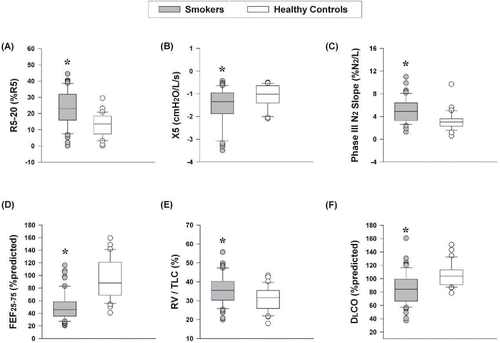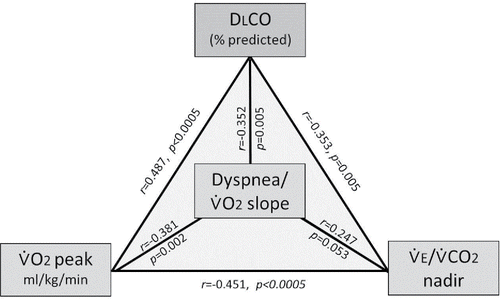Figures & data
Table 1. Subject characteristics and medications.
Table 2. Resting pulmonary function.
Figure 1. Measures of small airway dysfunction, pulmonary gas trapping, and lung diffusing capacity in smokers and age-matched healthy controls. (A) R5-20, (B) X5, (C) phase-III N2 slope, (D) FEF25–75% (% predicted), (E) RV/TLC (%), and (F) DLCO (% predicted). Values in box plots represent the median, 10th, 25th, 75th, and 90th percentile. *p < 0.05 smokers vs. healthy controls. Abbreviations: DLCO = diffusing capacity of the lung for carbon monoxide; FEF25–75% = maximal mid-expiratory flow; N2 = nitrogen; R5-20 = change in airway resistance from 5 to 20 Hz during impulse oscillometry (IOS); RV = residual volume; TLC = total lung capacity; X5 = distal capacitive reactance during IOS.

Table 3. Measurements at the peak of symptom-limited incremental cycle exercise.
Figure 2. Selected parameters of responses to incremental cycle exercise plotted against work rate in smokers and age-matched healthy controls. (A) Exertional dyspnea intensity using Borg scale, (B) ̇VE, (C) ̇VE/̇VCO2, (D) PetCO2, (E) IC, (F) IRV. Values are mean ± SEM. Square symbols represent the points at the highest equivalent work arte of 60 watts. *p < 0.05 smokers vs. healthy controls at rest, standardized work rates or at peak exercise. Abbreviations: IC = inspiratory capacity; IRV = inspiratory reserve volume; PetCO2 = partial pressure of end-tidal carbon dioxide; TLC = total lung capacity; ̇VE = minute ventilation; ̇VE/̇VCO2 = ventilatory equivalent for carbon dioxide.

Table 4. Correlates of each of the primary outcomes within smokers.
Figure 3. Inter-relationships between DLCO% predicted, peak ̇VO2, dyspnea/̇VO2 slope, and ̇VE/̇VCO2 nadir within the smoker group. DLCO correlated with peak ̇VO2 (r = 0.487, p < 0.0005), dyspnea/̇VO2 slope (r = −0.352, p = 0.005), and ̇VE/̇VCO2 nadir (r = −0.353, p = 0.005). Abbreviations: DLCO = diffusing capacity of the lung for carbon monoxide; ̇VE/̇VCO2 = ventilatory equivalent for carbon dioxide; ̇VO2 = oxygen uptake.

